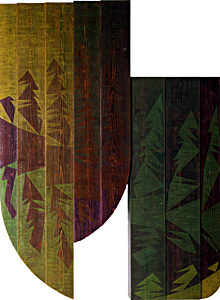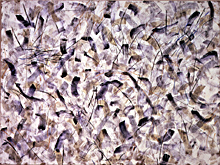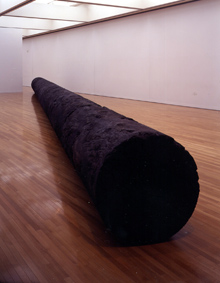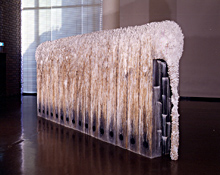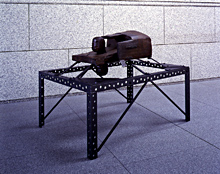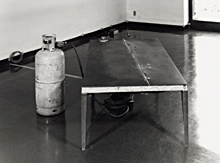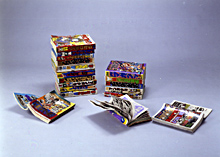4d
美共闘、ポスト概念派、ポストもの派
Bikyoto, Post Conceptualists, Post Mono-ha
【本文確定】
「今、美術家と呼ばれているなら、そこが戦場だ」(堀浩哉、美共闘1969年7月20日発行のアジビラから)。
学生運動に呼応して結成された堀浩哉、彦坂尚嘉らの「美共闘」は、美術家と呼ばれることの自明性を疑うことから出発しました*4d1。たとえば彦坂尚嘉が1970年代に繰り返し行った「Floor Event」は、実際に彼(=美術家と呼ばれているが自明ではない)が居住している空間に大量の生ゴムを撒くことで、彼(=生活を営む一市民)の日常が脅かされるというものでした。そして彼らは、日本概念派ともの派を、ともに「観念論的な神秘主義」として斥けました。この意味においては逆接的ですが、美共闘こそ、還元主義の正当な継承者でした。高度経済成長に終止符が打たれた1974年、彼らが自らに課した「ポイエーシス(制作)の禁止」はその象徴的事件です。すなわち松澤宥の「オブジェを消せ」や、李禹煥の「あるがまま」では不問に付されたままだった作家自身の超越性を、自己否定的に批判しようとしたのです。
ところがその頃には、日本概念派ともの派はすでに還元主義における禁欲を緩めつつありました。松澤宥は自己否定を人類否定へと拡大し「人類の消滅を急げ」と提言し続けることによって*4d2、むしろ多産な芸術活動へと邁進していました。李禹煥は1972年から「点より」「線より」のシリーズで、後述する絵画回帰の急先鋒でした。また、野村仁は物質の消滅過程を記録していましたが、記録がそれ自体作品として自立するようになりました (「moon score」のシリーズ等)。榎倉康二は染みや滲みの呈示だけでなく、作家本人の身体と物質の関係を問う写真や映像作品の発表を開始しました。
こうした「概念性/物質性への還元」(概念/物質についての美術)から「概念性/物質性の使用」(概念/物質による美術)への変質、すなわち負のベクトルから正のベクトルへの変質が、この時代、許容されました。そして還元主義という規範の後退から、多様性が招来しました。その意味では、還元主義を継承した美共闘や、還元主義にとどまり続けた他の作家たちも、この時代の多様性の一角を形成したことになります。
峯村敏明は1974年頃以降の美術の多様性、さらには1980年代前半の一部の傾向も含めて「ポストもの派」と一括しました*4d3。しかし「ポスト概念派」の語を対置させ、「概念による美術」をポスト概念派、「物質による美術」をポストもの派と図式化することも可能です。
さまざまなポスト概念派、ポストもの派の作家たちが輩出しました。1970年の安保闘争の頓挫による冷戦体制の固定化は、「核の傘」に守られた聖域を出現させたのだといえますが、美術においても万博や反博の芸術が急速に忘れられ、「美術内美術」という聖域が出現しました。円環の内に閉じた芸術は*4d4、1960年代の美術に比べれば、明らかにある種の晦渋な豊饒さをたたえました。個々の美術家はマイペースで美術の本質や役割を追求し、たとえば画廊で酒を飲み酩酊してしまうこともできたし(田窪恭治のイベント「バーボンが一本空くまでのはなし」1975)、眠りに落ちる前に羊を毎晩数えることもできました (高見澤文雄のテープ作品「柵を越えた羊の数」1974)。そして美術内美術からはみ出るエネルギーを感じさせた榎忠は、ハンガリー国へハンガリ(半刈)で行き(1978)、女装し網タイツ姿で「バー・ローズ・チュウ」を開き (1979)、広島型原爆を原寸大で復元しました(1982)。
"If we are to be called artists, then that is our battlefield" (Hori Kosai, Bikyoto; From agitational leaflets printed on July 20th 1969).
Bikyoto, which was founded by Hori Kosai and Hikosaka Naoyoshi in response to the student movements, started out as a group to question the obviousness of being called an artist*4d1. For example, Hikosaka's "Floor Event," which was performed repeatedly in the 1970s, involved scattering loads of raw rubbers in his (= He is called an artist but is not obvious) living space thereby threatening his (= citizens going about their daily life) daily life. They rejected both the Japanese Conceptualists and Mono-ha as being an "idealistic mysticism." In this sense, Bikyoto was unexpectedly the rightful successor to reductionism. This was emblematic of the self-imposed prohibition of poiesis (production) in 1974 when the rapid economic growth came to an end. In other words, they tried to critique in a self-denying way the transcendency of the artists whose works such as "Get Rid of Objects" by Matsuzawa Yutaka and "As It Is" by Lee U-Fan were overlooked.
But during this time, the Japanese Conceptualists and Mono-ha were beginning to soften their ascetic stance in their reductionism. Matsuzawa expanded his idea of self-denial to rejection of humanity and by continuously proposing to "speed up the eradication of humanity*4d2," he was pressing on with his prolific artistic activities. Lee was at the forefront of returning to doing paintings, a subject which will be touched upon later, from 1972 with his "From Point" and "From Line" series. Nomura Hitoshi was recording the process of the disappearance of matters, but the record itself became his artworks ("moon score" series, as well as others). Enokura Koji started to show not only works using stains and oozes, but also photography and video works which involve investigating the relationships between the artist's body and matters.
These changes from "reducing down to concepts / matters (art on concepts / matters)" to "use of concepts and matters (art by concepts / matters)," in others words changes from the negative vector to positive vector were permissible during this time. With this regression of reductionist norm was the rise of the notion of diversity. In this sense, it can be said that the Bikyoto which took on reductionism and other artists who remained faithful to reductionism formed part of the diversity of this era.
Minemura Toshiaki summed up the diversity of art after c.1974 and part of the trends during first half of the 1980s as "Post Mono-ha"*4d3. But it is also possible to contraposition the word "Post Conceptualists" used by Hikosaka and others to schematize "art by concepts" as Post Conceptualists and "art by matters" as Post Mono-ha.
Many Post-Conceptualist and Post Mono-ha artists came about. It can be said that the fixation of the Cold War regime due to the setback of the campaign against the Japan-U.S. Security Treaty in 1970 allowed for the emergence of the sanctuary protected under the "nuclear umbrella," but in the world of art, the art of the Expo and Anti-Expo were quickly forgotten and gave way to the emergence of the sanctuary, "art within art." This insular art*4d4, compared with art from the 1960s, clearly extolled certain obfuscatory richness in art. Individual artists were able to investigate the nature of art and its role at their own pace, were able to get excessively drunk after drinking at a gallery (Takubo Kyoji's event "Story of Until A Bottle of Bourbon Becomes Empty" 1975), and were able to count the sheeps before they fell asleep (Takamizawa Fumio's tape work "Number of Sheeps That Jumped Over The Fence" 1974). Enoki Chu, who exuded energy coming out of art within art, went to Hungary (hangari = half-shaved in Japanese) with half-shaved head in 1978, dressed in women's clothing with net stockings on and opened "Bar Rose Chu" in 1979, and built a replica of the atomic bomb dropped over Hiroshima in full scale in 1982.
